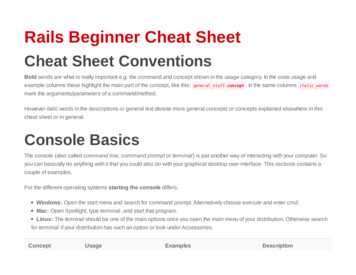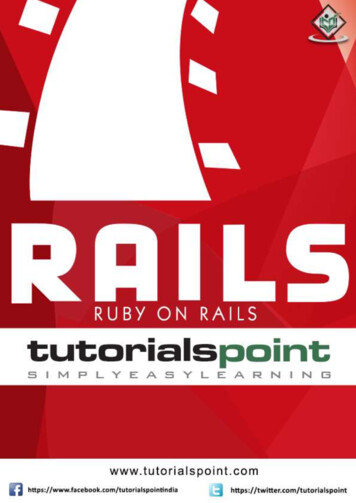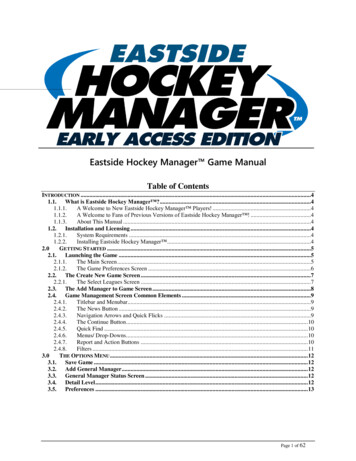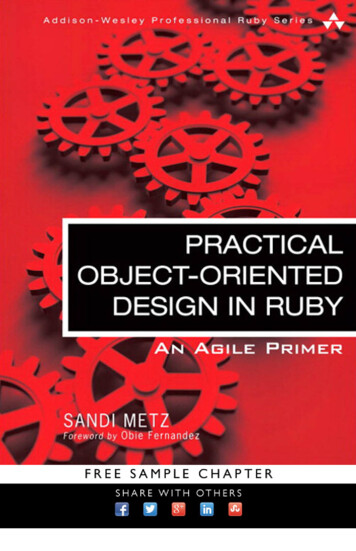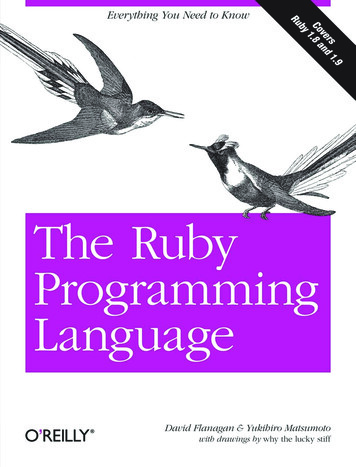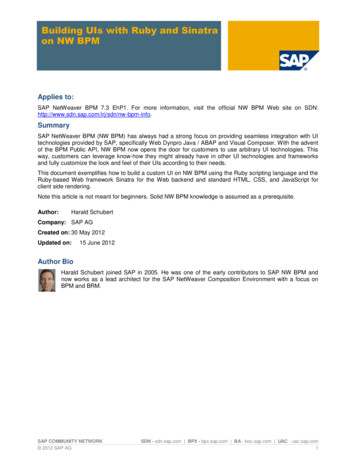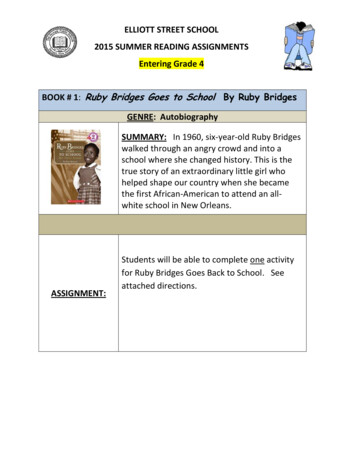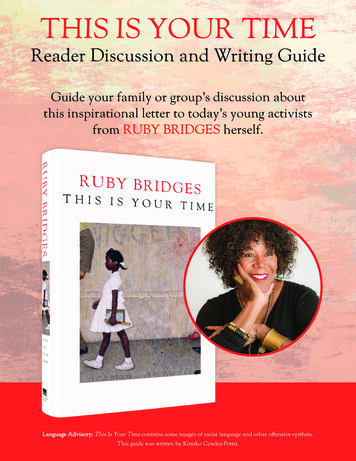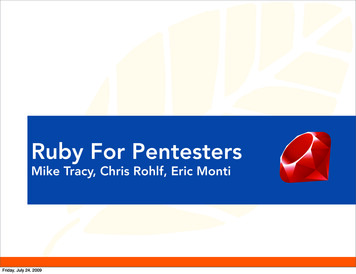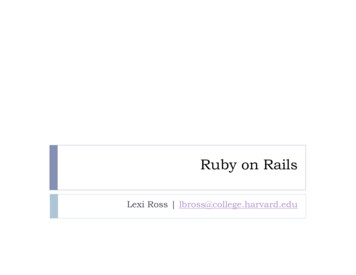
Transcription
Extracted from:Learn Game Programming with RubyBring Your Ideas to Life with GosuThis PDF file contains pages extracted from Learn Game Programming with Ruby,published by the Pragmatic Bookshelf. For more information or to purchase apaperback or PDF copy, please visit http://www.pragprog.com.Note: This extract contains some colored text (particularly in code listing). Thisis available only in online versions of the books. The printed versions are blackand white. Pagination might vary between the online and printed versions; thecontent is otherwise identical.Copyright 2015 The Pragmatic Programmers, LLC.All rights reserved.No part of this publication may be reproduced, stored in a retrieval system, or transmitted,in any form, or by any means, electronic, mechanical, photocopying, recording, or otherwise,without the prior consent of the publisher.The Pragmatic BookshelfDallas, Texas Raleigh, North Carolina
Learn Game Programming with RubyBring Your Ideas to Life with GosuMark SobkowiczThe Pragmatic BookshelfDallas, Texas Raleigh, North Carolina
Many of the designations used by manufacturers and sellers to distinguish their productsare claimed as trademarks. Where those designations appear in this book, and The PragmaticProgrammers, LLC was aware of a trademark claim, the designations have been printed ininitial capital letters or in all capitals. The Pragmatic Starter Kit, The Pragmatic Programmer,Pragmatic Programming, Pragmatic Bookshelf, PragProg and the linking g device are trademarks of The Pragmatic Programmers, LLC.Every precaution was taken in the preparation of this book. However, the publisher assumesno responsibility for errors or omissions, or for damages that may result from the use ofinformation (including program listings) contained herein.Our Pragmatic courses, workshops, and other products can help you and your team createbetter software and have more fun. For more information, as well as the latest Pragmatictitles, please visit us at https://pragprog.com.The team that produced this book includes:Brian P. Hogan (editor)Potomac Indexing, LLC (index)Cathleen Small; Liz Welch (copyedit)Dave Thomas (layout)Janet Furlow (producer)Ellie Callahan (support)For international rights, please contact rights@pragprog.com.Copyright 2015 The Pragmatic Programmers, LLC.All rights reserved.No part of this publication may be reproduced, stored in a retrieval system, or transmitted,in any form, or by any means, electronic, mechanical, photocopying, recording, or otherwise,without the prior consent of the publisher.Printed in the United States of America.ISBN-13: 978-1-68050-073-8Encoded using the finest acid-free high-entropy binary digits.Book version: P1.0—September 2015
CHAPTER 1IntroductionHello and welcome. This is a book about making games with and for yourcomputer—games like some of the ones you love on your computer, yourphone, or your game console. By working your way through this book, you’llmake four games, each of a different type. You’ll learn how to open a windowon your computer screen and then fill it with moving pictures. You’ll makethose images interact with each other, and you’ll control them with yourcomputer’s mouse and keys.The games we make will feel pretty familiar to you. They aren’t copies of othergames, but they do use familiar patterns and principles that you’ll be able touse to make your own games. The techniques you’ll learn for making aspaceship fly around by pressing keys on the keyboard can also help youmove a chicken across a road full of traffic. Each chapter in this book is basedon a few different elements of game creation, and each element is applicableto a wide range of games.The goal of this book is to help you bring your own ideas to life. When you’velearned these elements of game development, you’ll be able to take a gameyou’ve imagined and create that game so that it runs on your computer—andalso on your friends’ computers.Ruby and GosuAlong the way, you’ll level up your programming skills. Becoming a betterprogrammer will help you make great games, and making games will helpyou improve your programming skills. To make the games in this book you’lluse the Ruby programming language, along with a game library called Gosu.Ruby is a great language both for learning to program and for making games. Click HERE to purchase this book now. discuss
Chapter 1. Introduction 2It has “an elegant syntax that is natural to read and easy to write.”1 The Rubylanguage focuses on objects, and this makes it a great fit for creating games,as you’ll see as you work through this book.The Gosu game library will provide the structure for your games, while leavingtheir design and content completely up to you. It gives you the tools you needto place images on the screen, move them around, and play sounds to spiceup your game. At the same time, it doesn’t do anything you won’t understand.You and your code will always be in control of what’s happening in your gamewindow. Gosu is also a great springboard to other platforms. In particular,working with SpriteKit, Apple’s framework for making two-dimensional gamesfor iOS and OS X, feels like a natural step up from writing games with Gosu.Ruby and Gosu are free, open source software that work well on both Windowsand Mac OS X computers. You can download everything you need, so it’seasy to get started, and perhaps you’ll find other people willing to learn gameprogramming along with you in your school or town. There is an online community dedicated to game programming with Ruby and Gosu, with a showcasewhere people share their games and a forum where they ask and answerquestions.2 Many people in this community have shared both finished gamesand the code for those games, and these can be great sources for learningand inspiration.What You’ll NeedFirst, you’ll need a computer. It can be a Mac running OS X 10.9 or later, orit can be a Windows computer running Windows 7 or later. You need to becomfortable with the file system on your computer, so you can save files whereyou want them and organize them into folders.To get the most out of this book, you’ll need a little programming experience.If you have already used Ruby, you’re ready to go. If you have experience witha different programming language, you might want to pick up a book suchas Learn to Program [Pin09] or Programming Ruby 1.9 & 2.0 [FH13] and learna little Ruby syntax before you start on the games in this book.The Road AheadAs you go through this book, we’ll be making some games together. The gamesfollow a progression, and each chapter assumes that you have worked .libgosu.org/ Click HERE to purchase this book now. discuss
The Road Ahead 3the preceding chapters. Here is a summary of what you’ll be learning in eachchapter. In Chapter 2, Get Ready, on page ?, you’ll set up your computer to useRuby and Gosu to write games. In Chapter 3, Creating Your First Game, on page ?, you’ll make a simplegame. You’ll learn how a Gosu game is organized and how to use Gosuto open a window on your computer, fill it with pictures, and move thosepictures around. In Chapter 4, Creating a Sprite-Based Game, on page ?, you’ll begin anew game, Sector Five, in which a player controls a spaceship that shootsdown enemy invaders. Each thing you draw on the screen will be a sprite,and you’ll learn to create a class for each type of sprite in the game. In Chapter 5, Managing Lots of Sprites, on page ?, you’ll learn how tomanage many sprites by organizing them with arrays. By iterating throughthese arrays, you’ll be able to handle the movement and interactions ofmany sprites in the window at once. In Chapter 6, Adding Scenes and Sounds, on page ?, you’ll break yourgame into multiple scenes, giving it a start scene with some instructionsand an end scene with credits. You’ll learn how to add music and soundeffects to finish Sector Five. In Chapter 7, Creating a Puzzle Game, on page ?, you’ll create a puzzlegame called Twelve. This game focuses on user interaction, and you’lllearn how to write code to implement the rules of the game. In Chapter 8, Making a Platformer Game with Physics, on page ?, you’lluse a physics engine to make objects move naturally. In Escape, a herowill jump between platforms, dodging boulders that fall, spin, and bounce. In Chapter 9, Making a Side-Scrolling Game, on page ?, you’ll learn howto make your platformer game scroll, using a camera object to follow thehero’s motion. This will allow you to have a game field that is bigger thanyour screen. In Chapter 10, Package and Share Your Game, on page ?, you’ll learn topackage up a game into a single executable so you can share it with yourfriends.When we’re finished, you’ll have a better understanding of how games areput together, as well as some new programming tools in your toolbox. You’llbe ready to take your own ideas and turn them into games. Click HERE to purchase this book now. discuss
Chapter 1. Introduction 4Bumps in the RoadWhether you’re following a tutorial or writing your own code, it can be frustrating when things don’t work. This book tries to anticipate some of thesesituations and give you some strategies to deal with them. At these places inthe tutorial, you’ll find a section with some ideas for how to solve particularproblems.What If It Doesn’t Work?We’ll explore different sorts of problems that can occur and look at ways to solvethem. You’ll learn how to interpret some common errors and look at ways to findanswers on the Internet.Writing games is fun, and hopefully the rewards of making your programswork will outweigh the frustration you feel when they don’t. Sometimes theanswer will come to you only after you’ve walked away from the computer fora little while. Stick with it! Persistence is one of the most important assets aprogrammer can have.What’s NextBefore you can actually start making games, you’ll need to install a few thingson your computer. The next chapter will explain what you need and will takeyou step by step through getting ready. Click HERE to purchase this book now. discuss
If you have already used Ruby, you’re ready to go. If you have experience with a different programming language, you might want to pick up a book such as Learn to Program [Pin09] or Programming Ruby 1.9 & 2.0 [FH13] and learn a little Ruby syntax b
